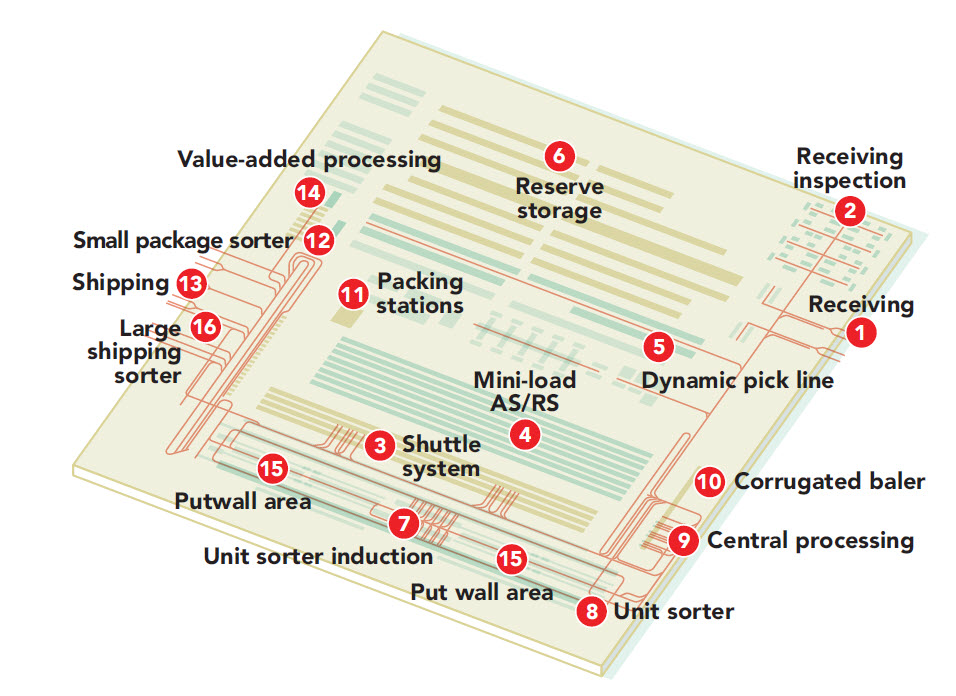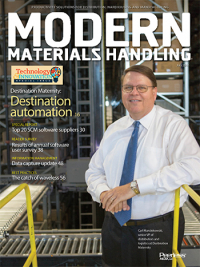The automation tool kit in action at Destination Maternity
Destination Maternity’s new facility brings together shuttles, mini-loads, a bomb-bay unit sorter and sophisticated software to drive a true omni-channel distribution environment.
Latest Material Handling News
Radial stays ahead of the automation curve Wireless Mobility: Ready for the next leg up AGVs set new standards for inventory transportation Inside North Shore Care Supply: Bringing robots to receiving Bergen Logistics: Putting robots to work in a multi-tenant facility More Equipment ReportDestination Maternity’s new highly automated distribution center in New Jersey is powered by an integrated warehouse management and execution system that manages all of the processes and equipment while balancing the workload throughout the facility.
Receiving:
When shipping containers arrive at receiving (1), an advanced ship notification (ASN) is downloaded from the enterprise resource planning (ERP) system and all containers must have compliant ASN labeling. Once a container is opened, an associate scans cases onto a receiving conveyor. From there, the system determines the storage location and storage medium based on the velocity of the product.
SKUs with the highest velocity or that will be shipped within two days of receipt are routed to a dynamic pick line (5). There cartons are scanned into storage locations.
SKUs with normal velocity or demand are routed to the mini-load (4), which can automatically store corrugated cartons or plastic totes.
Slow-moving SKUs are delivered to the reserve storage area (6).
Whenever possible, the shuttle (3) is replenished with newly received merchandise, which is transferred to a plastic tote. The shuttle holds one tote of every SKU managed in the facility.

Receiving inspection:
A select number of cases from every newly received purchase order are conveyed to the receiving inspection area (2). There, cartons are opened, inspected and verified. The items and the case are cubed for handling by the automation and for outbound containerization. Once the inspection and quality assurance are complete, product is re-cartonized, pushed onto a take-away conveyor and routed to the appropriate storage area (3,4,5,6).
Picking:
Since almost every order requires piece picking, a pick is a pick and an order is an order, regardless of the channel of business during the fulfillment process. When orders are released, the warehouse execution system (WES) determines the best storage medium from which to pull inventory. The shuttle (3) is always the first choice followed by the mini-load (4), reserve storage (6), the dynamic pick line (5) and inbound inventory (1, 2). The WES also assigns orders across the 600 chute locations served by the unit sorter (8).
Totes from the shuttle system (3) are routed directly to one of twelve induction stations along the unit sorter (8). An associate scans the tote and an item in the tote to verify that the correct contents have been delivered. Once that has been verified, the number of items to be inducted is displayed on a screen. After all the items required for the order have been inducted, the associated pushes the tote onto a take-away conveyor and it is returned to the shuttle (3). Totes stored in the mini-load (4) are handled just like totes from the shuttle (3). Corrugated cases, on the other hand, are first conveyed to a central processing area (9) for de-trashing. There, the contents of a carton are verified and scanned into a tote, which is then placed onto the conveyor system, routed to an induction station (7) and loaded onto the unit sorter (8). Empty corrugated cartons are sent to an automatic baler (10).
Order consolidation and packing:
Every order on the unit sorter (8) is assigned to a chute. Items are inducted onto a sorter tray and dropped into a container under the chute assigned for an order or group of orders. For instance, a batch of single piece orders may be assigned to a unique chute and aggregated into a tote. The WES tracks items as well as the weight and cube of the items as they drop.
When the system determines that a container is full, the overhead chute door automatically closes and a red light indicates the container is ready for the next step in the process. An associate closes out the container and pushes it onto a take away conveyer that routes it to the next stop.
Totes holding items for single item e-commerce orders, for instance, are routed to the packing station (11). There, the WES assigns an item to an order once it is scanned by an associate and automatically prints the shipping label and packing list. Once packed, shipping cartons or bags are placed on an overhead conveyor that routes them to a small package sorter (12). After crossing an in-line scale, the package is diverted to a service carrier lane in shipping (13) and placed in a Gaylord designated for the appropriate service level.
Wholesale customer orders requiring extra handling are routed to one of 12 stations in the value-added processing area (14). There, they are re-ticketed, packed for shipment and palletized if required. They go directly to shipping (13). Alternatively, customer order totes are routed to the pack out area (11) or to a put wall bay (15), where orders are consolidated into totes by customer.
In either scenario, once a tote is sent to the packing area, it is scanned by an associate who verifies that the contents of the tote match the requirements for the order displayed on a screen. Once the order is verified, the system prints out the pack list and shipping label for the shipping bag or carton. These are also placed on the overhead conveyor and sent to the small package sorter (12).
Finally, orders for stores drop into canvas totes while orders for leased stores are placed into corrugated containers. Store orders receive a pre-printed shipping label and security tag and are conveyed directly into an outbound UPS trailer in shipping (13). Corrugated containers destined for leased stores are closed and routed to a corrugated pack lane. There, they pass through a semi-automated taper line, a packing list is enclosed and a shipping label is applied. The cartons are then routed to shipping (13).
Shipping:
In order to get to shipping, Destination Maternity-owned and leased store shipping containers are conveyed to the large shipping sorter (16) where they are weighed by an in-line scale and scanner. Based on the weight and scan information, the WES diverts the container to the correct shipping lane (13), marks the status of the container as shipped and uploads a real-time shipment confirmation to the ERP system. Packages on the small package sorter (12) are handled in the same way, except that they are diverted to ship lanes (13) designated for small package carriers.
Systems Supplier
System Design and Integration, Warehouse Execution and Management Systems, Warehouse Controls and Put-to-Light System, Mini-Load and Shuttle AS/RS Systems: Invata Intralogistics
Conveyor and Sortation System: TGW
Unit (Bomb-Bay) Sorter and Chutes: EuroSort
Aligners: Intralox
RF Wearable and Hand-Held Scanners: Zebra Technologies (Motorola)
Fixed Scanners: SICK
Camera-Based Imagers: Cognex

Article Topics
Equipment Report News & Resources
Radial stays ahead of the automation curve Wireless Mobility: Ready for the next leg up AGVs set new standards for inventory transportation Inside North Shore Care Supply: Bringing robots to receiving Bergen Logistics: Putting robots to work in a multi-tenant facility High-tech meets low-tech: Automate storage for pallet loads Tuggers, carts work together to increase productivity and ergonomics More Equipment ReportLatest in Materials Handling
Beckhoff USA opens new office in Austin, Texas Manhattan Associates selects TeamViewer as partner for warehouse vision picking ASME Foundation wins grant for technical workforce development The (Not So) Secret Weapons: How Key Cabinets and Asset Management Lockers Are Changing Supply Chain Operations MODEX C-Suite Interview with Harold Vanasse: The perfect blend of automation and sustainability Consultant and industry leader John M. Hill passes on at age 86 Registration open for Pack Expo International 2024 More Materials HandlingAbout the Author
Subscribe to Materials Handling Magazine

Find out what the world's most innovative companies are doing to improve productivity in their plants and distribution centers.
Start your FREE subscription today.
April 2024 Modern Materials Handling

Latest Resources











